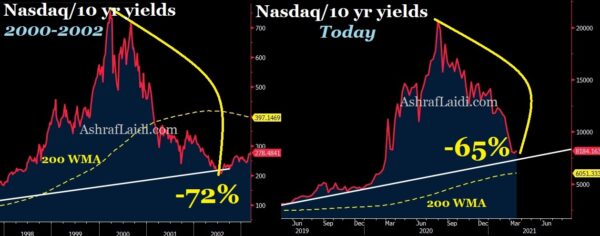The prices paid components of every manufacturing survey continue to soar as inflation pressures build but the market is increasingly taking a wait-and-see approach. The kiwi led the way on Monday while the euro lagged on vaccine worries. US retail sales are due up next. Here is the latest Nasdaq/10yr yield ratio compared to 2000/02.
The Empire Fed survey of New York-area manufacturing was slightly better than anticipated on Monday in another sign of strong demand but the real headline was in the ‘prices paid’ component, which continues to soar. The sequence in the past five months is: 64.4, 57.8, 45.5, 37.1, 29.1.
That’s a dramatic escalation and while the Fed can promise to see through it for now, those prices are going to hit consumers who will eventually want higher wages. For now, consumers are seeing the upside of higher home prices but the costs of raw materials lag considerably. At times, companies can’t pass those through the supply chain but with a tsunami of demand on the cusp of being released, there’s never been a better time for companies to hike prices.
Monday’s overall trade was relatively subdued. There was a brief flight into the US dollar after nearly all of Europe pulled the AstraZeneca vaccine on blot clotting worries. That’s unfortunate but the market quickly rebounding, perhaps concluding that fears are overblown or that other vaccines will quickly fill the gap. EU officials will have an update on Tuesday.
That news will compete with the US February retail sales report. The consensus is for a 0.5% decline after the +5.3% surge in January. The ‘control group’ is forecast down 0.9%. Those expected falls are in large part due to terrible weather in much of the US in the month and will be easily dismissed if they’re soft. On the other hand, if the consumer powered through the cold and snow, then it’s another sign of a powerful reopening trend.
China Data Highlights Re-Opening Tailwind
The February 2020 lockdown in China has since been overshadowed by the pandemic everywhere but with a slate of data to start the week, the numbers highlighted the rebound. The Canadian dollar was the top performer last week while the yen lagged; that same pair is the best trade so far in 2021. CFTC data showed a drop in the crowded euro long position.
The year-over-year increases in Chinese February data were remarkable. Industrial output was up 35.1% y/y compared to 30.0% expected. Retail sales rose 33.8% y/y versus 32.0% expected and new construction starts were up 64.3% y/y.
Of course, that all reflects the depths of the shutdown as much as the strength of the recovery.
At the same time, it underscores the pipeline of positive headlines that will reverberate throughout the world as the reopening ramps up.
CFTC Commitments of Traders
Speculative net futures trader positions as of the close on Tuesday. Net short denoted by – long by +.
EUR +102K vs +126K prior
GBP +34K vs +36K prior
JPY +7K vs +19K prior
CHF +14K vs +12K prior
CAD +11K vs +15K prior
AUD +8K vs +6K prior
NZD +17K vs +16K prior
Divergent policy paths from the ECB and Fed continue to show up in the CFTC positioning data as the crowded long thins out. Rate differentials have moved sharply in the US dollar’s favour and all signs point to a sharp divergence in near-term growth expectations. The latter half of the year will narrow that divergence but that’s a trade for later.













